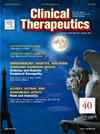不同美沙拉嗪剂型对6-硫鸟嘌呤核苷酸治疗小儿溃疡性结肠炎的疗效比较。
IF 3.6
4区 医学
Q2 PHARMACOLOGY & PHARMACY
引用次数: 0
摘要
目的:美沙拉嗪和硫嘌呤是治疗小儿溃疡性结肠炎(UC)的重要药物。根据给药机制,美沙拉嗪可以不同形式给药,可影响硫嘌呤代谢,导致6-硫鸟嘌呤核苷酸(6-TGN)水平升高。因此,在同时使用这两种药物时,必须考虑它们的相互作用。本研究旨在分析小儿UC患者根据美沙拉嗪配方的6-TGN。方法:我们回顾性分析了在2021年1月至2023年12月期间在单一医疗中心就诊的236例儿科UC患者的数据。在纳入的患者中,198人服用了硫嘌呤,其中136人接受了6-TGN检测。结果:氮唑嘌呤(AZA)平均剂量为0.66 mg/kg, 6-TGN平均水平为211.64 pmol/8 × 10^8红细胞(rbc)。同时使用时间依赖性美沙拉嗪和AZA组的平均6-TGN水平为245.00 pmol/8 × 10^8红细胞,而同时使用多基质美沙拉嗪(MMX)和AZA组的平均6-TGN水平为141.97 pmol/8 × 10^8红细胞(P < 0.001)。在同一患者中,时间依赖性美萨拉嗪治疗期间的平均6-TGN水平为290.34 pmol/8 × 108红细胞,而切换到MMX后的平均6-TGN水平为148.54 pmol/8 × 108红细胞(P = 0.016)。意义:MMX和AZA治疗组的平均6-TGN水平低于时间依赖性美沙拉嗪和AZA治疗组。在同一患者中,从时间依赖性美沙拉嗪切换到MMX后,平均6-TGN水平显着降低。因此,与使用时间依赖性美沙拉嗪相比,使用MMX时需要更高剂量的AZA才能达到目标6-TGN水平。本文章由计算机程序翻译,如有差异,请以英文原文为准。
Comparison of Effects on 6-Thioguanine Nucleotides According to Mesalazine Formulation in Pediatric Patients with Ulcerative Colitis
Purpose
Mesalazine and thiopurines are important therapeutic agents for pediatric patients with ulcerative colitis (UC). Mesalazine, which may be administered in different forms depending on delivery mechanisms, can affect thiopurine metabolism, leading to increased 6-thioguanine nucleotides (6-TGN) levels. Therefore, when using these two drugs simultaneously, their interactions must be considered. This study aimed to analyze 6-TGN according to mesalazine formulation in pediatric patients with UC.
Methods
We retrospectively reviewed the data of 236 pediatric patients with UC who visited a single health center between January 2021 and December 2023. Among the enrolled patients, 198 were administered thiopurines, and of these, 136 underwent testing for 6-TGN.
Findings
The mean dose of azathioprine (AZA) was 0.66 mg/kg, and the mean 6-TGN level was 211.64 pmol/8 × 10^8 red blood cells (RBCs). The mean 6-TGN level for the group concurrently using time-dependent mesalazine and AZA was 245.00 pmol/8 × 10^8 RBCs, while that for the group concurrently using multimatrix mesalazine (MMX) and AZA was 141.97 pmol/8 × 10^8 RBCs (P < 0.001). In the same patients, the mean 6-TGN level during time-dependent mesalazine treatment was 290.34 pmol/8 × 108 RBCs, whereas the mean 6-TGN level measured after switching to MMX was 148.54 pmol/8 × 108 RBCs (P = 0.016).
Implications
The group treated with MMX and AZA had a lower mean 6-TGN level than the group treated with time-dependent mesalazine and AZA. The mean 6-TGN level significantly decreased after switching from time-dependent mesalazine to MMX in the same patients. Therefore, when administering MMX, a higher dose of AZA is necessary to reach the target 6-TGN level, compared to the dose required when using time-dependent mesalazine.
求助全文
通过发布文献求助,成功后即可免费获取论文全文。
去求助
来源期刊

Clinical therapeutics
医学-药学
CiteScore
6.00
自引率
3.10%
发文量
154
审稿时长
9 weeks
期刊介绍:
Clinical Therapeutics provides peer-reviewed, rapid publication of recent developments in drug and other therapies as well as in diagnostics, pharmacoeconomics, health policy, treatment outcomes, and innovations in drug and biologics research. In addition Clinical Therapeutics features updates on specific topics collated by expert Topic Editors. Clinical Therapeutics is read by a large international audience of scientists and clinicians in a variety of research, academic, and clinical practice settings. Articles are indexed by all major biomedical abstracting databases.
 求助内容:
求助内容: 应助结果提醒方式:
应助结果提醒方式:


